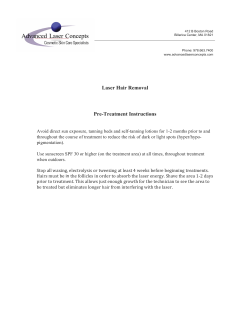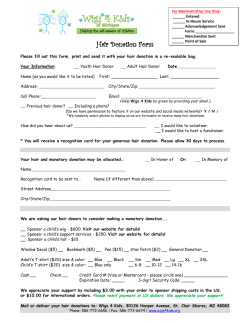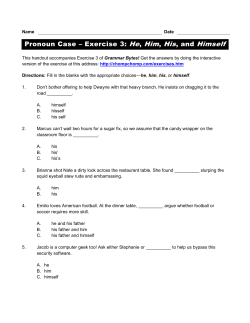
Skin, Integumentum commune
Skin, Integumentum commune Surface area of the skin: cca 2 m2 thin skin (hirsute) thick skin (glabrous) – covers the greater part of the body – hair, sweat- and sebaceous glands – fingertip, palmar- and plantar surfaces – hairless, only sweat glands Layers: Epidermis (thin skin 100 µm-25 cell layers, thick skin 1 mm – 100 cell layers) stratified keratinized squamous epithelium, no vessels Dermis - mechanical resistance, numerous papillae or rete ridges glands and hair follicles Epidermis + Dermis: Cutis Subcutis (subcutaneous tissue) – (loose) connective tissue, fat pad Epidermis+Dermis+Subcutis: Skin, Integumentum commune Skin appendages: 1. Hair and Nail (short – vellus hairs... long – terminal hairs) 2. Glands 3 Epidermis 1 stratum basale/germinativum 2 stratum polygonale/spinosum 3 stratum granulosum (4 stratum lucidum – absent in thin skin) 5 stratum corneum: str. compactum + disjunctum 1+2: Malpighi layer 4 3 2 1 1 2 3 5 Keratinocyte Langerhans cell Merkel cell Melanocyte Cell types in the epidermis 1. Keratinocytes (90 %) - basal living cells, dead keratinized cells superficially → str. basale – mitotic activity → prickle cells – desmosomes with tonofilaments (cytokeratin) → str. granulosum – profillagrin providing clumping of tonofilaments in keratohyalin granules - release of extracellular lipids from lamellar bodies → str. corneum: fillagrin (matrix) + keratin filaments → KERATIN cell is lacking nucleus cornified envelope – involucrin protein - (inner surface of the membrane) cornified lipid envelope – ceramide (outer surface of the membrane, which is linked to the cornified envelope by covalent bounds epidermal turnover time (from stratum basale until desquamation): 52-75 days (in psoriasis around 8 days) stratum spinosum (prickle cell layer) Cell types in the epidermis 2. Langerhans cells (Mononulcear-Phagocyte System), antigenpresenting cells Cell types in the epidermis 3. Melanocytes - its dendritic processes are contact with cca 36 keratinocytes, the most are clear because the melanosomes are transferred to the keratinocytes by cytocrine secretion (stimulated by UV radiation, TNF-alpha, ACTH, alpha-MSH) melanin – tyrosine/tyrosinase reaction (its mutation – albinism) in darker skin: more large superficial melanosomes eumelanin (brown-black), pheomelanin (red-yellow) Marker D5 in Nucleus... Sunless bronze: dihydroxyacetone binds to proteins of stratum corneum only Cell types in the epidermis 4. Merkel cells - later, with receptors.... Dermo-epidermal junction ◘ molecular anchorage 1. tonofilaments – Desmosomes 2. basal cells –lamina densa – hemidesmosomes anchoring filaments attach the cells to lamina densa (laminin5, BP 180/ coll XVII) 3. anchoring fibrils of type VII collagen bind lamina densa to collagen fibers (type III) in papillary dermis 4. microfibrils link the elastic fibers to collagen fibers Skin diseases! Autoantibodies against hemidesmosomes or specific proteins, coll. XVII, VII, etc. → formation of blisters, epidermolysis DERMIS ◘ papillary layer – loose connective tissue, fine collagen fibers (type I and III) capillary loop, nerve endings, Meissner‘s-corpuscles ◘ reticular layer: dense connective tissue, thick collagen fibers (type I) & elastic fibers, smooth muscles cells in some cases such as tunica dartos of penis & scrotum Langer‘s lines (long axis of rhomboids) – long axis of rhomboids frequently coincide (but not always) with relaxed skin tension lines (Kraissle‘s lines) (wrinkle lines are related to muscle contraction) - excision line must be parallel to the relaxed skin tension lines dermal papillae – friction ridges fingerprint - dermatoglyphics flexure (joint) line SUBCUTIS or HYPODERMIS (also known as superficial fascia) loose (adipose) connective tissue - mediates increased mobility of skin -panniculus adiposus: shock absorber, energy store, thermal insulation -retinaculum cutis (dense collagenous): strong binding to underlying tissues in certain areas of the skin: (sole, palm, scalp) – no significant sliding - very delicate in eyelids, forskin skin turgor – exsiccation (dehydration) Glands of the skin recapitulation!!! 1. sebaceous - holocrine: open into hair follicles (or onto the skin surface: lips, inner surface of prepuce, minor labia, glans of penis/clitoris, areola/nipples) - missing in the sole & palm 2. sudoriferous – merocrine (eccrine) sweat : open onto the skin surface - missing in lips, inner surface of prepuce, minor labia, glans of penis/clitoris - cholinergic sympathetic innervation 3. odoriferous - apocrine (sweat): open into hair follicles - axillary, areolar, anal genital regions + (glands of Moll & ceruminous glands) - adrenergic sympathetic innervation branched alveolar simple coiled tubular branched alveolar - arteriovenosus anastomoses or shunts against heat loss in certain areas of the skin (fingertips, nose, ear) superficial (subpapillary) plexus mid-dermal venous plexus deep (subdermal) plexus lymphatic vessels begin in the dermal papilla dermatome cutaneous area supplied by one spinal nerve - dermatomes of adjacent spinal nerves overlap markedly Functions of the skin ◘ Receptor organ ◘ Mechanical and chemical protection (stratified epithelium, (hemi)desmosomes etc, fiber network in dermis and subcutis) ◘ Thermoregulation: passive – (insulation by subcutis – panniculus adiposus) active – sweat glands, vessels, m. arrector pili ◘ Photoprotection: stratum corneum reflects UV rays melanin – scavanger of harmful free radicals ◘ Permeability barrier: stratum corneum keratin & extracellular lipid + stratum granulosum tight junctions → sealing against water loss (in reptiles first – terrestrial life) ◘ Protection against pathogens: sweat pH 4-6, fatty acids in sebum, (RNases!) ◘ Synthesis of vitamin D, cytokines and growth factors (EGF) --------------------------------------------------------------------------------------------◘ Barrier also to penetration of hydrophilic molecules → only lipophilic medications (creams/ointments) can penetrate through the intact epidermis hair everywhere except on palms, soles, lips, nipples, glans penis/clitoris, labia minora, inner aspects of forskin and labia majora infundibulum X isthmus inf. segment hair bulb pilosebaceous unit: hair, hair follicle, m. arrector pili, sebaceous gland X follicular bulge inner root sheath outer root sheath hair glassy membrane connective tissue sheath hair cuticle cortex medulla dermal papilla melanocyte capillary loop cuticle Huxley‘s layer Henle‘s layer hair bulb inner root sheath Hair (pilum) - Hair follicle (downgrowth of epidermis) Hair shaft – Hair sheats Hair bulb - 1. germinal matrix cells differentiate into medulla, cortex, cuticle, inner root sheath - 2. connective tissue dermal papilla hair grows outwards, nuclei of the matrix cells are lost, keratinization Hair – 3. medulla 4. cortex 5. cuticle – shingle-like (upside down) several layers of cornified squames by interdigitations with the cuticle of inner root sheat achieves a firm anchorage of hair root within its sheath 9 8 7 6 5 4 3 1 2 hair root is surrounded by the hair follicle (folliculus pili) ◘ 6.inner root sheath - sheath cuticle, Str. lucidum →Huxley‘s layer, Str. granulosum → Henle‘s layer ◘ 7.outer root sheath (Malpighi layer) ◘ 8.glassy membrane (basal membrane) ◘ 9.connective tissue sheath cross section of the hair follicle -(adipose tissue of the subcutis) - connective tissue sheath - glassy membrane - outer root sheath (cell-rich and basophil) - inner root sheath (indistinct cell borders, eosinophil) - cuticle of the inner root sheath (followed by a white gap) -cuticle of hair - cortex of hair - medulla of hair Role of hair: thermoregulation, against UV radiation (scalp), sensory function Hair cycle Growth Involution Rest Shedding of hair normal hair loss: 50-100/day when synchronised: shed of hair (mammals and newborns....) chemotherapy – harmful effects on matrix cells or on their blood supply, rupture of hair root cross section: round – straight hair, oval – curly hair androgen (DHT) induces hair loss (alopecia) – short anagen phase color of hair depends on the amount and type of pigments dermis of the nail bed is anchored to the periosteum – no subcutis, distinct compartment painful infections/haematoma – excision of plate! Nail Nail plate Nail matrix Nail bed
© Copyright 2025









